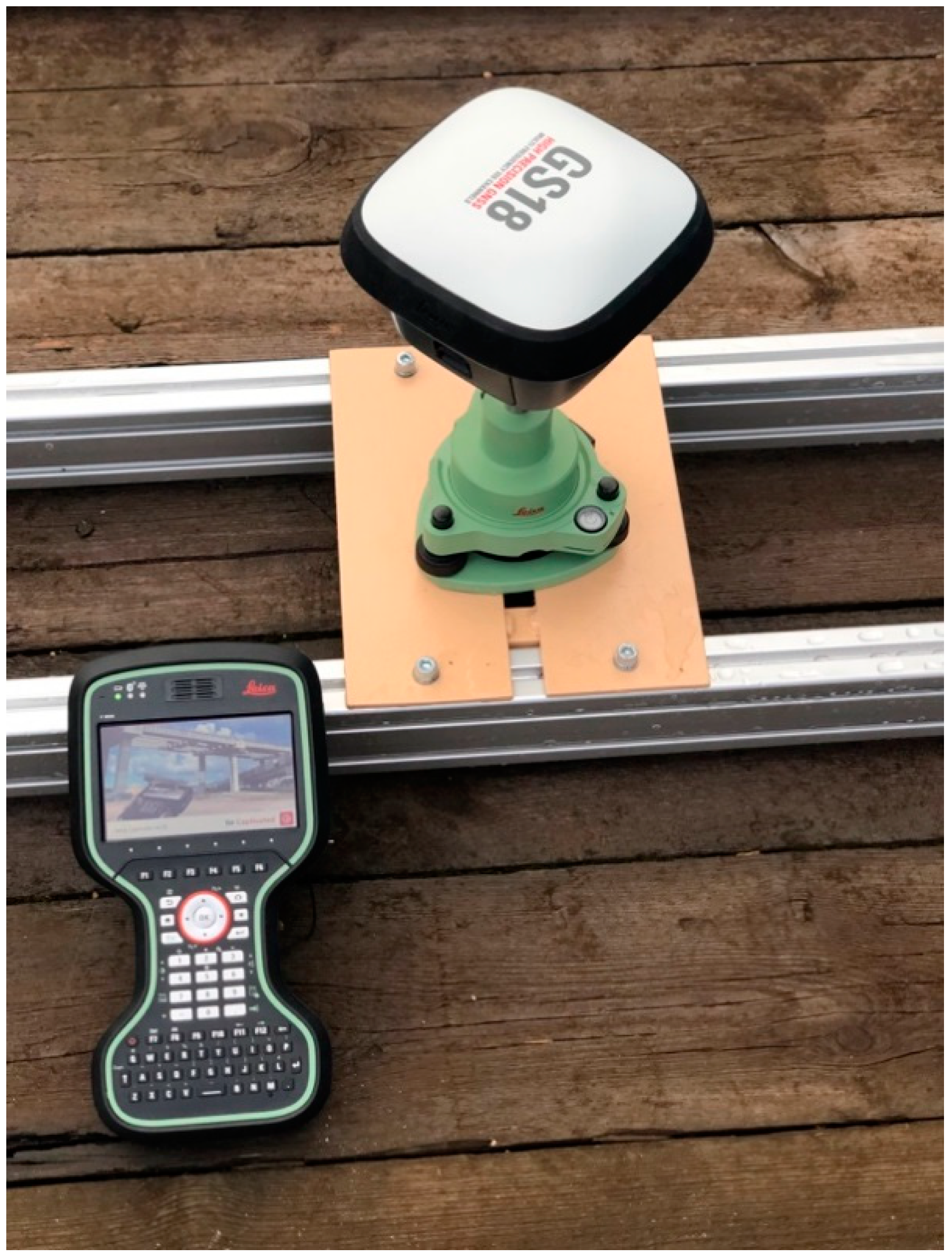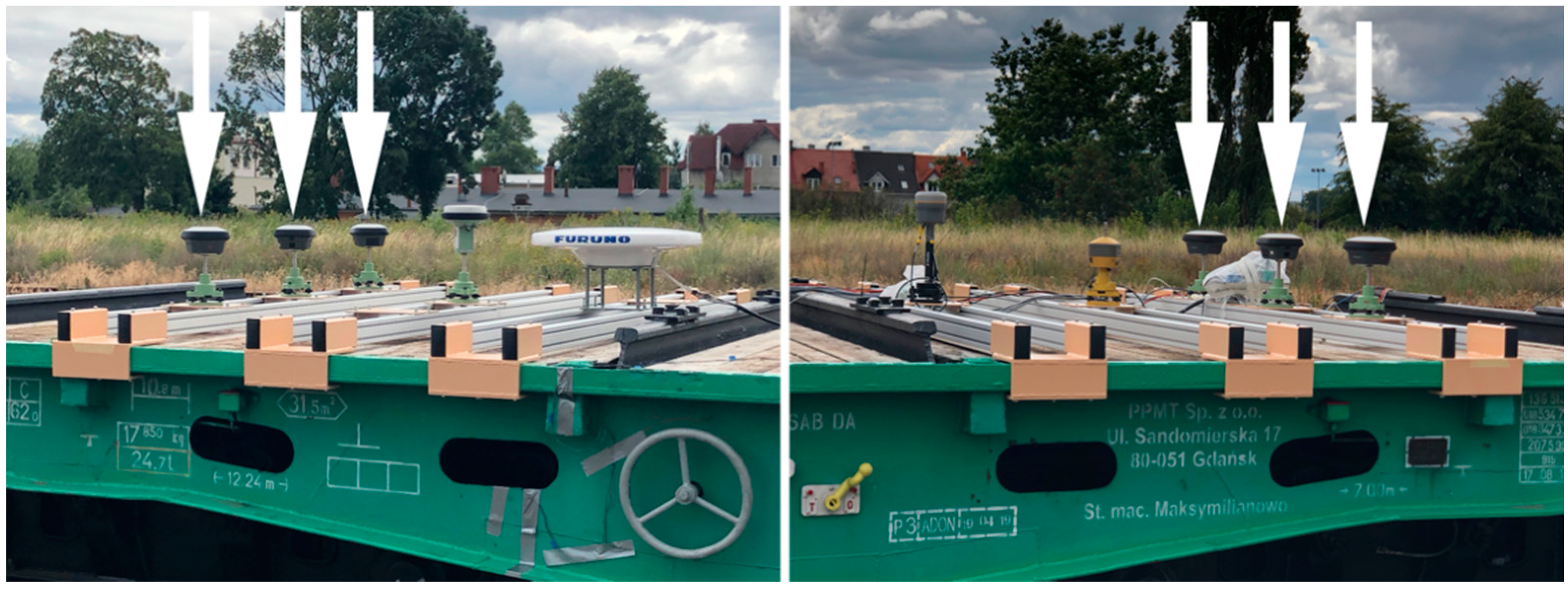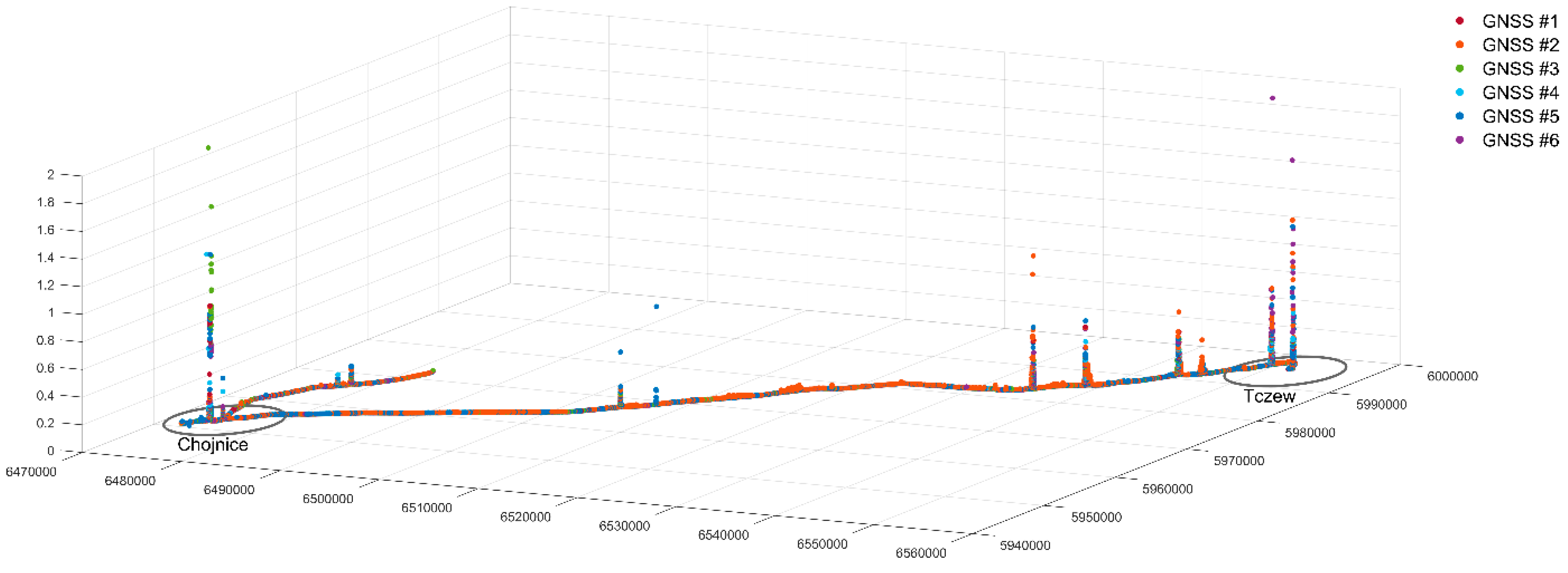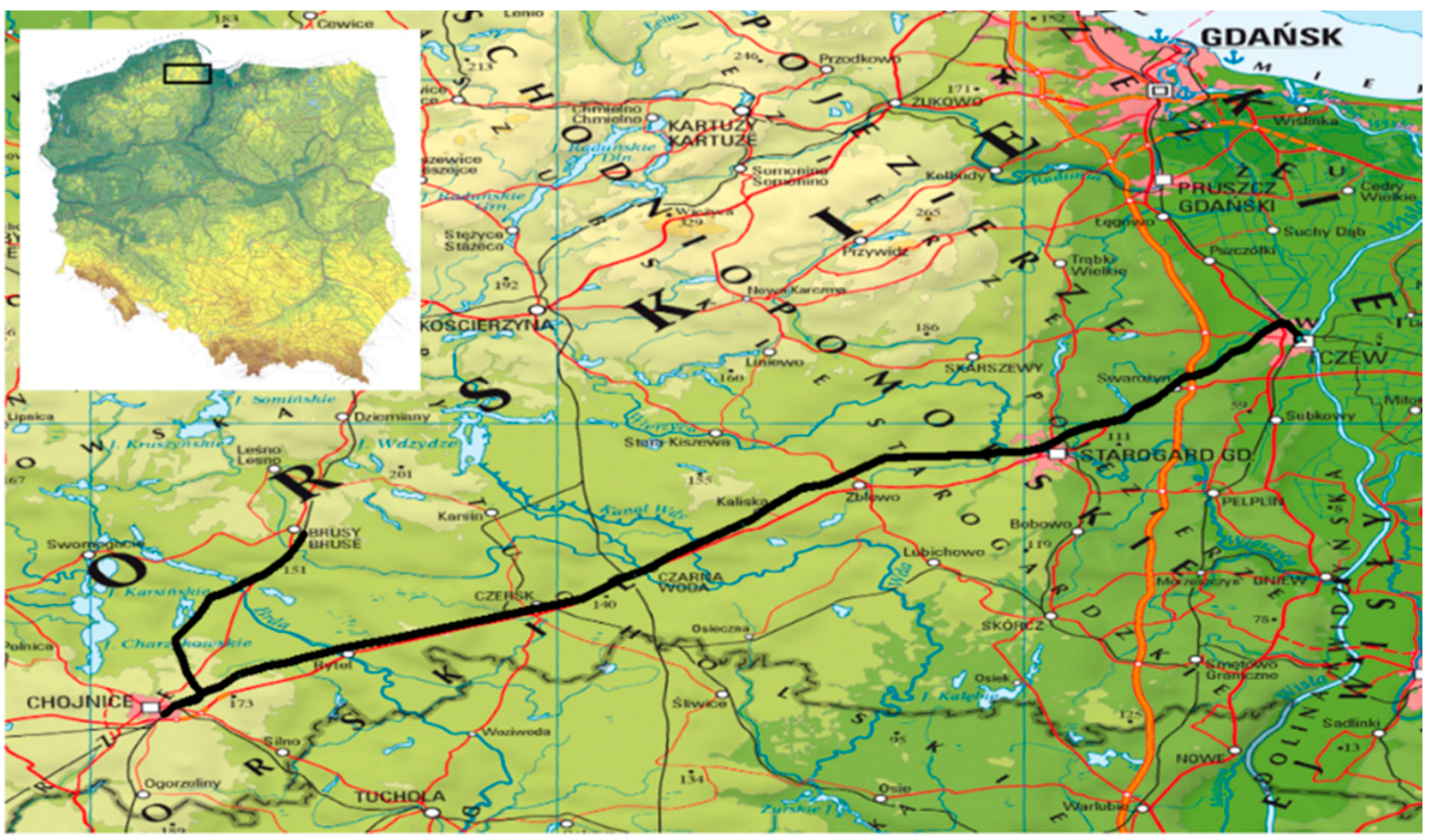Application of Least Squares with Conditional Equations Method for Railway Track Inventory Using GNSS Observations
Abstract
1. Introduction
2. Mobile Surveying Platform
3. Theoretical Basis of the Method of Least Squares with Conditional Equations
4. Practical Applications of GNSS in Railway Surveys and Alignment Results
- coordinates of GNSS antennas on the MSP,
- errors in determining the GNSS antenna position coordinates.
- for GNSS #1 in 99.59%
- for GNSS #2 in 99.00%
- for GNSS #3 in 99.59%
- for GNSS #4 in 99.63%
- for GNSS #5 in 99.19%
- for GNSS #6 in 99.62%
5. Conclusions
Author Contributions
Funding
Conflicts of Interest
References
- Sahin, I. Railway traffic control and train scheduling based oninter-train conflict management. Transp. Res. Part B Methodol. 1999, 33, 511–534. [Google Scholar] [CrossRef]
- Yang, L.; Qi, J.; Li, S.; Gao, Y. Collaborative optimization for train scheduling and train stop planning on high-speed rail ways. Omega 2016, 64, 57–76. [Google Scholar] [CrossRef]
- Assefa, E.; Lin, L.J.; Sachpazis, C.; Feng, D.H.; Shu, S.X.; Anthimos, S. Anastasiadis, Probabilistic Slope Stability Evaluation for the New Railway Embankment in Ethiopia. Elect. J. Geotech. Eng. 2016, 21, 4247–4272. [Google Scholar]
- Zoccali, P.; Loprencipe, G.; Lupascu, R.C. Acceleration measurements inside vehicles: Passengers’ comfort mapping on railways. Measurement 2018, 129, 489–498. [Google Scholar] [CrossRef]
- Strach, M. Surveying of Railroads and Related Facilities and Developing Results for the Conventional Railway Modernization. In Archiwum Fotogrametrii, Kartografii i Teledetekcji; Polish Society of Photogrammetry and Remote Sensing: Warsaw, Poland, 2009; Volume 19, ISBN 978-83-61576-09-9. (In Polish) [Google Scholar]
- Grabias, P. Geodezyjne i diagnostyczne techniki pomiaru geometrii torów kolejowych. Res. Tech. Pap. Pol. Assoc. Trans. Eng. Crac. 2017, 1, 65–79. (In Polish) [Google Scholar]
- Czaplewski, K. Global Positioning System: Political Support, Directions of Development, and Expectations. TransNav Int. J. Marine Navig. Saf. Sea Transp. 2015, 9, 229–232. (In Polish) [Google Scholar] [CrossRef]
- Czaplewski, K. Does Poland Need eLoran? In Management Perspective for Transport Telematics: 18th International Conference on Transport System Telematics, TST 2018, Krakow, Poland, 20–23 March 2018; Mikulski, J., Ed.; Springer: Cham, Switzerland, 2018; Volume 897, pp. 525–544. [Google Scholar] [CrossRef]
- Januszewski, J. Applications of Global Navigation Satellite Systems in Maritime Navigation. Sci. J. Marit. Univ. Szczec. 2016, 2016, 74–79. (In Polish) [Google Scholar] [CrossRef]
- Biały, J.; Ciecko, A.; Cwiklak, J.; Grzegorzewski, M.; Koscielniak, P.; Ombach, J.; Oszczak, S. Aircraft Landing System Utilizing a GPS Receiver with Position Prediction Functionality. In Proceedings of the 24th International Technical Meeting of the Satellite Division of the Institute of Navigation (ION GNSS), Portland, OR, USA, 19–23 September 2011; Institute of Navigation: Manassas, VA, USA, 2012; pp. 457–467. [Google Scholar]
- Urbanski, J.; Morgas, W.; Specht, C. Perfecting the Maritime Navigation Information Services of the European Union. In Proceedings of the 2008 1st International Conference on Information Technology, Gdansk, Poland, 18–21 May 2008; pp. 237–240. (In Polish). [Google Scholar]
- Czaplewski, K.; Zwolan, P. A Vessel’s Mathematical Model and Its Real Counterpart: A Comparative Methodology Based on a Real-world Study. J. Navig. 2016, 69, 1379–1392. [Google Scholar] [CrossRef]
- Koc, W.; Specht, C. Wyniki pomiarów satelitarnych toru kolejowego. Tech. Transp. Szyn. 2009, 15, 58–64. (In Polish) [Google Scholar]
- Koc, W.; Specht, C.; Jurkowska, A.; Chrostowski, P.; Nowak, A.; Lewiński, L.; Bornowski, M. Określanie przebiegu trasy kolejowej na drodze pomiarów satelitarnych. In Proceedings of the II Scientific and Technical Conference Design, Construction and Maintenance of Infrastructure in Rail Transport INFRASZYN 2009, Zakopane, Poland, 22–24 April 2009; pp. 170–187. (In Polish). [Google Scholar]
- Specht, C.; Nowak, A.; Koc, W.; Jurkowska, A. Application of the Polish Active Geodetic Network for Railway Track Determination. In Transport Systems and Processes: Marine Navigation and Safety of Sea Transportation, 1st ed.; Weintrit, A., Neumann, T., Eds.; CRC Press/Balkema: Leiden, The Netherlands, 2011; pp. 77–81. [Google Scholar] [CrossRef]
- Specht, C.; Specht, M.; Dąbrowski, P. Comparative Analysis of Active Geodetic Networks in Poland. In Proceedings of the 17th International Multidisciplinary Scientific GeoConference SGEM 2017, Albena, Bulgaria, 29 June–5 July 2017; Volume 17, pp. 163–176. [Google Scholar]
- Specht, C.; Mania, M.; Skóra, M.; Specht, M. Accuracy of the GPS Positioning System in the Context of Increasing the Number of Satellites in the Constellation. Pol. Marit. Res. 2015, 22, 9–14. [Google Scholar] [CrossRef]
- Specht, C.; Koc, W.; Smolarek, L.; Grządziela, A.; Szmagliński, J.; Specht, M. Diagnostics of the Tram Track Shape with the use of the Global Positioning Satellite Systems (GPS/Glonass) Measurements with a 20 Hz Frequency Sampling. J. Vibroeng. 2014, 16, 3076–3085, ISSN 1392-8716. [Google Scholar]
- Specht, C.; Koc, W. Mobile Satellite Measurements in Designing and Exploitation of Rail Roads. Transp. Res. Procedia 2016, 14, 625–634. [Google Scholar] [CrossRef][Green Version]
- Specht, C.; Koc, W.; Chrostowski, P.; Szmaglinski, J. Accuracy Assessment of Mobile Satellite Measurements Relation to the Geometrical Layout of Rail Tracks. Metrol. Measur. Syst. 2019, 26, 309–321. (In Polish) [Google Scholar]
- Koc, W. Design of Rail-Track Geometric Systems by Satellite Measurement. J. Transp. Eng. ASCE 2012, 138, 114–122. [Google Scholar] [CrossRef]
- Koc, W.; Chrostowski, P. Computer-Aided Design of Railroad Horizontal Arc Areas in Adapting to Satellite Measurements. J. Transp. Eng. ASCE 2014, 140, 04013017. [Google Scholar] [CrossRef]
- Koc, W. The analytical design method of railway route’s main directions intersection area. Open Eng. 2016, 1. [Google Scholar] [CrossRef]
- Koc, W.; Specht, C.; Chrostowski, P.; Szmagliński, J. Analysis of the possibilities in railways shape assessing using GNSS mobile measurements. MATEC Web Conf. 2019, 262, 11004. [Google Scholar] [CrossRef]
- Specht, C.; Koc, W.; Chrostowski, P. Computer-aided evaluation of the railway track geometry on the basis of satellite measurements. Open Eng. 2016, 6, 125–134. [Google Scholar] [CrossRef]
- Gikas, V.; Daskalakis, S. Determining Rail Track Axis Geometry Using Satellite and Terrestrial Geodetic Data. Surv. Rev. 2008, 40, 392–405. [Google Scholar] [CrossRef]
- Chen, Q.; Niu, X.; Zhang, Q.; Cheng, Y. Railway track irregularity measuring by GNSS/INS integration. Navigation 2015, 62, 83–93. [Google Scholar] [CrossRef]
- Chen, Q.; Niu, X.; Zuo, L.; Zhang, T.; Xiao, F.; Liu, Y.; Liu, J. A Railway Track Geometry Measuring Trolley System Based on Aided INS. Sensors 2018, 18, 538. [Google Scholar] [CrossRef] [PubMed]
- Lou, Y.; Zhang, T.; Tang, J.; Song, W.; Zhang, Y.; Chen, L. A Fast Algorithm for Rail Extraction Using Mobile Laser Scanning Data. Remote Sens. 2018, 10, 1998. [Google Scholar] [CrossRef]
- Puente, I.; González-Jorge, H.; Martínez-Sánchez, J.; Arias, P. Review of mobile mapping and surveying technologies. Measurement 2013, 46, 2127–2145. [Google Scholar] [CrossRef]
- Salvador, P.; Naranjo, V.; Insa, R.; Teixeira, P. Axlebox accelerations: Their acquisition and time-frequency characterization for railway track monitoring purposes. Measurement 2016, 82, 301–312. [Google Scholar] [CrossRef]
- Pham, N.T.; Timofeev, A.N.; Nekrylov, I.S. Study of the errors of stereoscopic optical-electronic system for railroad track position. In Proceedings of the Optical Measurement Systems for Industrial Inspection XI, SPIE 11056, Munich, Germany, 24–27 June 2019. [Google Scholar] [CrossRef]
- Zhu, F.; Zhou, W.; Zhang, Y.; Duan, R.; Lv, X.; Zhang, X. Attitude variometric approach using DGNSS/INS integration to detect deformation in railway track irregularity measuring. J. Geod. 2019, 93, 1571–1587. [Google Scholar] [CrossRef]
- Gao, Z.; Ge, M.; Li, Y.; Shen, W.; Zhang, H.; Schuh, H. Railway irregularity measuring using Rauch–Tung–Striebel smoothed multi-sensors fusion system: Quad-GNSS PPP, IMU, odometer, and track gauge. GPS Solut. 2018, 22, 36. [Google Scholar] [CrossRef]
- Li, Q.; Chen, Z.; Hu, Q.; Zhang, L. Laser-Aided INS and Odometer Navigation System for Subway Track Irregularity Measurement. J. Surv. Eng. 2017, 143, 04017014. [Google Scholar] [CrossRef]
- Kurhan, M.B.; Kurhan, D.M.; Baidak, S.Y.; Khmelevska, N.P. Research of railway track parameters in the plan based on the different methods of survey. Nauka Ta Prog. Transp. 2018, 2, 77–86. [Google Scholar] [CrossRef]
- Izvoltova, J.; Cesnek, T. Accuracy analysis of continual geodetic diagnostics of a railway line. In Proceedings of the 10th International Scientific and Professional Conference on Geodesy, Cartography and Geoinformatics (GCG 2017), Low Tatras, Slovakia, 10–13 October 2017; pp. 53–58. [Google Scholar]
- Sanchez, A.; Bravo, J.L.; Gonzalez, A. Estimating the Accuracy of Track-Surveying Trolley Measurements for Railway Maintenance Planning. J. Surv. Eng. 2017, 143, 05016008. [Google Scholar] [CrossRef]
- Czaplewski, K.; Waz, M.; Zienkiewicz, M.H. A Novel Approach of Using Selected Unconventional Geodesic Methods of Estimation on VTS Areas. Mar. Geod. 2019, 42, 447–468. [Google Scholar] [CrossRef]
- Zienkiewicz, M.H.; Czaplewski, K. Application of Square M-Split Estimation in Determination of Vessel Position in Coastal Shipping. Pol. Marit. Res. 2017, 24, 3–12. [Google Scholar] [CrossRef]
- Wisniewski, Z. Rachunek Wyrównawczy w Geodezji z Przykładami; Wydawnictwo UWM: Olsztyn, Poland, 2016; 468p. (In Polish) [Google Scholar]
- Kubáčková, L.; Kubáček, L.; Kukuča, J. Probability and Statistics in Geodesy and Geophysics; Elsevier: Amsterdam, The Netherlands, 1987; 427p. [Google Scholar]
- Rao, C.R. Linear Statistical Inference and Its Applications; John Wiley and Sons: Hoboken, NJ, USA, 2001; 656p. [Google Scholar]
- Wisniewski, Z. Methods for solving a system of interdependent conditional equations. Geod. Kartogr. 1985, 34, 39–52. [Google Scholar]
- Bakuła, M.; Kaźmierczak, R. Technology of Rapid and Ultrarapid Static GPS/GLONASS Surveying in Urban Environments. In Proceedings of the Baltic Geodetic Congress (BGC Geomatics), Gdansk, Poland, 22–25 June 2017. [Google Scholar] [CrossRef]
- Zienkiewicz, M.H. Deformation Analysis of Geodetic Networks by Applying Msplit Estimation with Conditions Binding the Competitive Parameters. J. Surv. Eng. 2019, 145, 04019001. [Google Scholar] [CrossRef]
- Czaplewski, K.; Specht, C.; Dąbrowski, P.; Specht, M.; Wiśniewski, Z.; Koc, W.; Wilk, A.; Karwowski, K.; Chrostowski, P.; Szmagliński, J. Use of a Least Squares with Conditional Equations Method in Positioning a Tramway Track in the Gdansk Agglomeration. TransNav Int. J. Mar. Navig. Saf. Sea Transp. 2019, 13, 895–900. [Google Scholar] [CrossRef]
- Rozporządzenie Rady Ministrów z Dnia 15 Października 2012 r. w Sprawie Państwowego Systemu Odniesień Przestrzennych. Available online: http://isap.sejm.gov.pl/isap.nsf/DocDetails.xsp?id=WDU20120001247 (accessed on 3 July 2020).
- HxGN SmartNet. Network of Reference Stations. Available online: https://leica-geosystems.com/pl-pl/services-and-support/hxgn-smartnet-satellite-positioning-service (accessed on 3 July 2020).
- Geoportal360.pl: Geoportal Polski, Wszystkie Działki na Mapie. Available online: https://geoportal360.pl (accessed on 3 July 2020).









| Parameter | Value |
|---|---|
| Signals Tracked | GPS (L1, L2, L2C, L5), Glonass (L1, L2, L2C, L32), BeiDou (B1, B2, B32), Galileo (E1, E5a, E5b, Alt-BOC, E62), QZSS (L1, L2C, L5, L62), NavIC L53, SBAS (WAAS, EGNOS, MSAS, GAGAN), Band L |
| Initialisation Time | Normally 4 s |
| Rtk Accuracy | A single baseline: Hz 8 mm + 1 ppm/V 15 mm + 1 ppm Network RTK: Hz 8 mm + 0.5 ppm/V 15 mm + 0.5 ppm |
| Postprocessing Accuracy | Static mode (phase), long-term observations: Hz 3 mm + 0.1 ppm/V 3.5 mm + 0.4 ppm, Static and fast static mode (phase): Hz 3 mm + 0.5 ppm/V 5 mm + 0.5 ppm |
| Weight | 1.20 kg/3.50 kg—a standard configuration of an RTK receiver on a pole |
| Dimensions | 173 mm × 173 mm × 108 mm |
| Position Measurement | 5 Hz/20 Hz |
| GNSS Receiver | x | y | m |
|---|---|---|---|
| GNSS #1 | 5967572.5583 | 6505456.2272 | 0.0669 |
| GNSS #2 | 5967571.9058 | 6505456.6093 | 0.2609 |
| GNSS #3 | 5967571.2635 | 6505456.9836 | 0.0966 |
| GNSS #4 | 5967576.0405 | 6505462.2802 | 0.0046 |
| GNSS #5 | 5967575.3857 | 6505462.6552 | 0.0285 |
| GNSS #6 | 5967574.7377 | 6505463.0309 | 0.0404 |
| Station Name | x | y |
|---|---|---|
| Starogard Gdański | 5981664.913 | 6532343.251 |
| Konarzyny | 5965574.243 | 6460849.453 |
| Czersk | 5962606.324 | 6498027.094 |
| Receiver | m [m] | mmax | |||||||
|---|---|---|---|---|---|---|---|---|---|
| 0–0.001 | 0.001–0.005 | 0.005–0.05 | 0.05–max | ||||||
| n | % | n | % | n | % | n | % | ||
| GNSS #1 | 495,231 | 97.63% | 9938 | 1.96% | 1965 | 0.39% | 116 | 0.02% | 0.831 |
| GNSS #2 | 455,199 | 89.74% | 46,981 | 9.26% | 4738 | 0.93% | 333 | 0.07% | 2.068 |
| GNSS #3 | 496,176 | 97.82% | 8971 | 1.77% | 1963 | 0.39% | 141 | 0.03% | 1.983 |
| GNSS #4 | 492,935 | 97.18% | 12,438 | 2.45% | 1707 | 0.34% | 171 | 0.03% | 1.206 |
| GNSS #5 | 465,407 | 91.75% | 37,738 | 7.44% | 3824 | 0.75% | 282 | 0.06% | 2.908 |
| GNSS #6 | 497,205 | 98.02% | 8122 | 1.60% | 1784 | 0.35% | 140 | 0.03% | 1.506 |
| Receiver | Minimal Value | Maximal Value | Mean Value | Confidence Intervals for the Mean (α = 0.05) | Variance | Standard Deviation | Sample Size |
|---|---|---|---|---|---|---|---|
| GNSS #1 | 1.592 × 10−6 | 0.831 | 3.099 × 10−4 | 1.712 × 10−5 | 4.138 × 10−3 | 507,216 | |
| GNSS #2 | 4.557 × 10−7 | 2.068 | 6.161 × 10−4 | 3.251 × 10−5 | 5.702 × 10−3 | 507,216 | |
| GNSS #3 | 5.999 × 10−7 | 1.983 | 3.297 × 10−4 | 4.651 × 10−5 | 6.820 × 10−3 | 507,216 | |
| GNSS #4 | 9.948 × 10−7 | 1.206 | 3.047 × 10−4 | 9.743 × 10−5 | 3.121 × 10−3 | 507,216 | |
| GNSS #5 | 8.365 × 10−7 | 2.908 | 5.643 × 10−4 | 8.087 × 10−5 | 8.993 × 10−3 | 507,216 | |
| GNSS #6 | 6.732 × 10−7 | 2.613 | 3.611 × 10−4 | 1.065 × 10−4 | 1.032 × 10−2 | 507,216 | |
| Total | 4.557 × 10−7 | 2.908 | 4.143 × 10−4 | 4.890 × 10−5 | 6.993 × 10−3 | 3,043,296 |
© 2020 by the authors. Licensee MDPI, Basel, Switzerland. This article is an open access article distributed under the terms and conditions of the Creative Commons Attribution (CC BY) license (http://creativecommons.org/licenses/by/4.0/).
Share and Cite
Czaplewski, K.; Wisniewski, Z.; Specht, C.; Wilk, A.; Koc, W.; Karwowski, K.; Skibicki, J.; Dabrowski, P.; Czaplewski, B.; Specht, M.; et al. Application of Least Squares with Conditional Equations Method for Railway Track Inventory Using GNSS Observations. Sensors 2020, 20, 4948. https://doi.org/10.3390/s20174948
Czaplewski K, Wisniewski Z, Specht C, Wilk A, Koc W, Karwowski K, Skibicki J, Dabrowski P, Czaplewski B, Specht M, et al. Application of Least Squares with Conditional Equations Method for Railway Track Inventory Using GNSS Observations. Sensors. 2020; 20(17):4948. https://doi.org/10.3390/s20174948
Chicago/Turabian StyleCzaplewski, Krzysztof, Zbigniew Wisniewski, Cezary Specht, Andrzej Wilk, Wladyslaw Koc, Krzysztof Karwowski, Jacek Skibicki, Paweł Dabrowski, Bartosz Czaplewski, Mariusz Specht, and et al. 2020. "Application of Least Squares with Conditional Equations Method for Railway Track Inventory Using GNSS Observations" Sensors 20, no. 17: 4948. https://doi.org/10.3390/s20174948
APA StyleCzaplewski, K., Wisniewski, Z., Specht, C., Wilk, A., Koc, W., Karwowski, K., Skibicki, J., Dabrowski, P., Czaplewski, B., Specht, M., Chrostowski, P., Szmaglinski, J., Judek, S., Grulkowski, S., & Licow, R. (2020). Application of Least Squares with Conditional Equations Method for Railway Track Inventory Using GNSS Observations. Sensors, 20(17), 4948. https://doi.org/10.3390/s20174948










